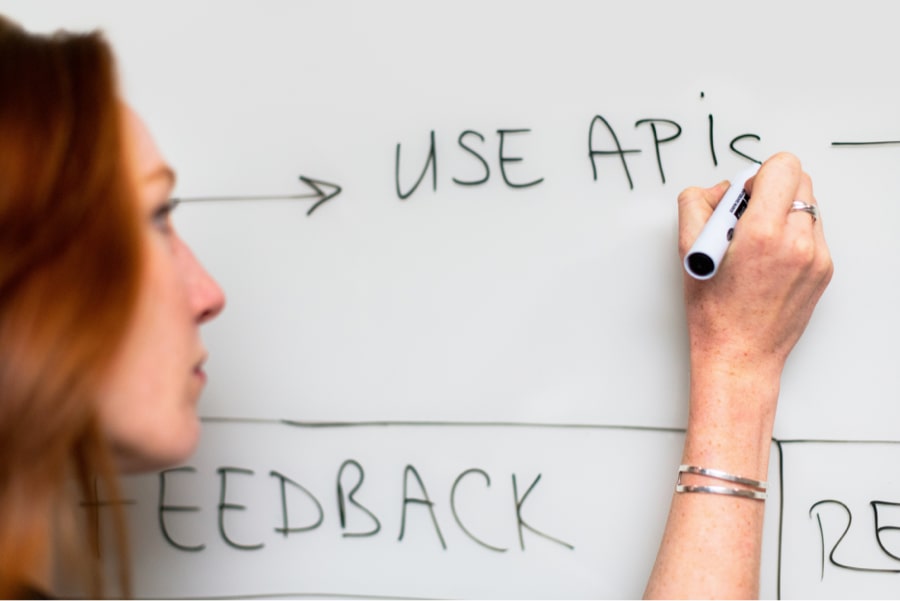
What Is An Open Banking API? Open Banking APIs Explained
When you’re trying to learn more about Open Banking APIs, it can be difficult to find an ideal starting point. It’s a highly technical topic. Most of the materials you’ll find may also sound almost robotic.
To change things up a bit, we’re going to get started with the basics. Then, we will explain the benefits of Open Banking APIs in simple terms. To keep everything at ground level, we will go over Open Banking API use cases and common examples of Open Banking used today.
Open Banking Explained

First of all, what is Open Banking?
Open Banking is a secure method for giving financial service providers access to your financial information.
Small businesses are often unable to understand the scope of financial products and services available to them. By securely sharing information, small (and even medium) sized businesses can gain access to better financial products and services.
Because it’s so accessible, Open Banking enables you to delve deeper into the finance industry. It also enables you to learn more about the state of your financial accounts. Finally, it can provide you with new ways to make the most of your finances.
The concept of Open Banking is simple enough. But, of course, the devil is in the details.
To reap the benefits of Open Banking, you need a safe and secure framework.
How does it work?
Open Banking application programming interfaces (APIs) are software solutions that enable different applications to interact with each other. This makes them the connecting link between the user and the institutions, essentially.
With an API, the software of Bank Number One can communicate with the software Bank Number Two and still come out with the same information. That way, despite their different software, both banks can share financial data in a secure format.
Individuals can also authorise banks to share their data with third parties. To do so, you just need to grant permission. At this point, your bank and the third party service provider of your choice can share the information securely through APIs
In these ways, Open Banking APIs have already started to revolutionize the finance industry.
Benefits of Open Banking

Open Banking is a hot topic in the financial industries for a reason. The uniting theme of why is that it paves the way for innovation. It offers brand new services, as well as innovative new ways for current and older financial products and services to be delivered.
Let’s look over how Open Banking APIs are benefiting the finance industry. Then, let’s look at what they have to offer all kinds of businesses.
Fintech Companies
One great benefit of Open Banking is that it gives fintech businesses the ability to better deliver their services. With Open Banking APIs, fintech companies can ensure a far better user experience. This is now possible because fintech providers can rely on the same structure as your bank.
Banks
Of course, fintech companies are not the only beneficiaries, as banks have their own reasons to embrace Open Banking. By taking part in this Open Banking API architecture, they are fostering a new environment that surrounds them. So, banks can leverage these developments to
- Leverage the same new technologies
- Attract new customers within the new environment
Banks are required to provide their own APIs as per regulations. They can better serve their customers by:
- Accepting permission to share data such as
- Profile information
- Account balances
- Transaction history
- Initiating payments on their customers’ behalf
Normal Individuals
Normal people who don’t work in fintech or banking can also benefit. Open Banking gives you more control over their financial information from all their bank accounts. These benefits can materialize by:
- Allowing a secure connection between your bank information and your favourite budgeting applications
- Enabling you to find better loan deals more efficiently
- Making it easier to use your bank account to verify your identity
- Quickly providing information such as the affordability of a home loan
Financial Service Providers
Financial businesses can gain better access to customers’ bank data over a trusted medium. This can be provided easily and quickly over an Open Banking mobile app, for example.
The benefits to financial service providers are similar to those provided to other financial businesses. Financial professionals that use an Open Banking API architecture are ideally situated to offer efficient and safe service delivery to their clients.
On top of safe and efficient access to information, finance professionals can use Open Banking APIs for integration into your app. New software can be used alongside Open Banking APIs to provide even more benefits. The scope of this software is wide, so let’s have a look at how it can be applied in different businesses.
How Open Banking can transform your business

Open Banking offers several things you can benefit from almost immediately. To understand those benefits, we need to break down Open Banking into the categories it allows for.
Analytics
Open Banking APIs have paved the road towards more meaningful and efficient analysis. On top of open but safe data sharing, you can add additional software meant to work with APIs. Bank API integration is offered alongside this software.
Some software is programmed to analyse your financial data. Depending on the software you use, you can receive:
- Highlights and insights for financial trends
- Recommendations to improve financial management
Automation
Many manually completed administrative tasks can be made more efficient with Open Banking APIs. Normally, you will have to access these features with an Open Banking app. There are several different tasks you can currently have automated. So, we’ll go over some of them when we go over Open Banking API use cases.
Aggregation
Aggregation platforms are software solutions that take advantage of Open Banking APIs. They use APIs to access your business financial data from any banks (and other financial institutions) it uses.
Using a bank account aggregation API, you will have all your banking data aggregated to a single, secure location.
What this all means for you is that you don’t need to log into several apps or websites anymore. You can manage all your business bank accounts, loans, and other financial products from the same location. This means better organisation and saving a lot of time.
Enhanced Banking
Some software working with Open Banking APIs will be able to enhance your banking experience. The way this normally works is the software would securely track your financial behaviour. During this process, it will collect data that can be used to automatically suggest better financial products and services.
Based on your behaviour, this kind of software can suggest:
- Better solutions to financial problems
- The best loans to handle a specific challenge
- A better way to handle consistent challenges, such as seasonal cash flow fluctuations
Open Banking adoption Challenges

The road of innovation always has its bumps and even its potholes. The same is true of Open Banking adoption, which can be a difficult thing for many businesses to implement. The other challenge is that the difficulties of Open Banking adoption are different depending on where you are in the world. The challenges Asian businesses face will be quite different from the ones businesses face in the EU.
Standardisation
That brings us to the first challenge, which is a lack of a universal Open Banking API standard. Open Banking is a global phenomenon, but there is no global standard for adoption and integration. Standardisation of Open Banking APIs is a long-term goal, and there are currently only country-based, or in the case of the EU, region-based standards.
Let’s take the example of Switzerland, which has its own Swiss Open Financial API (SOFA). SOFA is meant to create a common API for all businesses in the Swiss financial service sector. Relative to many regions, Switzerland is ahead of the trend. The same can be said of the EU with PSD2, or of South Korea which launched Asia’s first common API infrastructure.
Unfortunately, while this is the future of mass API integration, many countries have yet to catch up on their standardisation process. This may limit your access to the Open Banking APIs and associated applications that you would want.
Trust
Trust is the foundation of Open Banking. Financial fraud is now a global industry worth more than £3 trillion. When it comes to Open Banking, there are still concerns over security and privacy. Depending on who you talk to, Open Banking is either a security nightmare waiting to happen or an innovation that is the future of financial security.
Open Banking API integration explained

Many people are already benefiting from open banking API integration without even knowing it. The most common example now in daily life is “neobanks”. Neobanks are direct, online banks where all functions are completed online exclusively. More than 20% of Americans use these banks.
Neobanks don’t necessarily have traditional banking licenses. But they are normally built on top of traditional banking infrastructure. They are then connected with their customers through APIs.
Open banking API integration requires a lot of engineering. Normally, it follows a process that looks a lot like this:
- A planning stage, where strategic goals are determined. The engineers must lay out all major functions, normally while focussing on one broader category.
- Preparation, when the hypotheses in the first stage are tested. This is an important stage, as APIs are a competitive market and many open banking APIs that are put forward end up with very low demand in the market. This requires fast testing, quickly scaling what works, and mercilessly discarding what doesn’t.
- Evaluation, when the effects of the Open Banking API implementation are tested for a business. Then, goals need to be re-evaluated and tested.
- Audit for security weaknesses as well as positive effects surrounding efficiency
- Product development, when the Open Banking API architecture is altered and compliance with regulations is ensured.
- Customization (read “custom integration process”).
- Partnership ecosystem creation, enabling third parties to cooperate with banks to create new services and optimize performance.
Top Open Banking platforms
Let’s go over a few examples of Open Banking in action.
Stripe Connect
Stripe is a financial services/software company based in both San Fransisco and Dublin. But the company’s Stripe Connect is the service that offers sets of unified APIs that enable Open Banking. They do so by enabling businesses to offer, accept, and manage online payments.
Stripe Connect is one of the more well-known API service providers, with over 175,000 Twitter followers and hundreds of positive reviews on neutral platforms. The company brings its longstanding reputation, which is critical in the Open Banking API space, with an A+ rating alongside its accreditation with the Better Business Bureau.
Railsbank
Railsbank specialises in simple Open Banking API solutions. Like Stripe Connect, this company’s service is backed by a reputable company in the fintech/financial services space.
The platform offers APIs for developers to embed financial services into your apps or online customer service portals. Their services are global, so international transactions are a normal part of their service. They also offer a free API Key for those who sign up with them.
Custom integration process
One thing you’ll notice when you start using Open Banking APIs is how different each one is from all the others. Personalisation of services is a big part of the industry.
Open Banking API adoption will come with differences based on several variables:
- Geography
- Authentication needs
- Service Level Agreement of the service
- Other
If you need a customised solution and have open banking api specifications you should reach out to a dedicated software company. Software and fintech companies that specialise in Open Banking API integration can put together the solutions you need.
Open Banking Real-life Use Cases

There several benefits to Open Banking APIs. But if you look at the real banking API use cases, you will notice that there are more possibilities than meet the eye. But here are a few open banking API examples.
Check Deposits
After digitally deposited paper checks, paperless check deposits is the next stage of check deposit efficiency. But now you even have the option of using an API to get bank transactions completed instantly.
When your bank gives you a debit card, they are giving you a key to access their services. But bank cards inevitably come with several problems. First, there is safety. Cards are lost or stolen all the time, and their information can be stolen, meaning physical theft isn’t even necessary for a criminal to steal your funds. The Nilson report found that the total cost of bank card fraud from 2010 to 2017 was $0.068 per $100 sent in ALL transactions. This is a problem that has been aggravated by a global pandemic, during which fraudulent transactions rose 35%.
The good news is that the same studies project that the cost of card fraud will fall substantially by 2027. So, how can Open Banking APIs contribute to this progress?
In short, your mobile phone could become a more secure version of every single card you would normally carry. Even your watch could.
With the right infrastructure, an Open Banking API can allow you to use your phone to choose the card you want to use to make a payment. You can have an ATM dispense cash with the touch of a button on your phone. So, how is this more secure than a bank card? What if your phone is stolen?
Open Banking APIs use more modern authentication processes than bank cards do. With a card, you just need to know the PIN to use a bank machine. With tap enabled, you don’t even need to know your PIN to make a transaction that isn’t too large. Multi-factor authentication, on the other hand, can include a PIN and other more unique and appropriate authentication measures. Biological authentication, such as fingerprint authentication, can remove the problems of forcing you to remember PINs. You carry the “password” for your banking needs at all times.
Mobile banking is already increasingly popular around the world. With Open Banking APIs, you can get all the added security we’ve gone over. You also get faster service.
Business owners can thus also benefit by integrating Open Banking APIs. For banks, withdrawal from an ATM or branch worker via mobile is safe, fast, and seamless.
Risk Scoring
Risk scoring algorithms are used for a range of functions. Notably, the British NHS now uses one to track Covid-19. But risk scoring is used throughout the healthcare, insurance, and financial service industries, among others.
As an example of Open Banking APIs improving risk scoring algorithm application, imagine you offer debt management services. Your risk scoring algorithm can be applied via an API to reduce the time it takes to conduct your risk analysis.
The more impactful applications of risk scoring algorithms implemented via APIs include the mortgage industry. The loan application process can be long, but Open Banking API integration can make the process far faster and simpler. Your algorithms can be applied on a secure, open platform, optimising a lot of the slower security and administrative processes.
Next Steps

Applying Open Banking APIs to your organisation can offer the benefits we’ve gone over. This is a highly technical process, but with the right help, it can be made so much easier.
Boston Unisoft is experienced in financial software development. Our core values are confidentiality, security, data integrity, and regulatory compliance. On top of that, we offer unprecedented quality in code and software performance.
To get started, reach out for an Open Banking API consultation. Boston Unisoft offers consultation, API selection, and assistance with each logistical step.